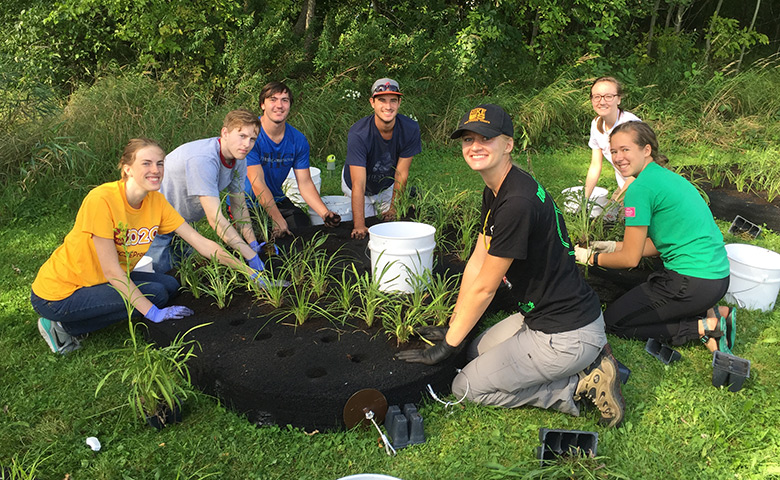New islands for Minnesota’s Fleming Lake
August 22, 2016

McGREGOR, Minnesota (Aug. 22, 2016)--Fleming Lake will now have innovative floating islands- and they are not your typical vacation islands. These man-made BioHaven® floating islands create a floating eco-system that improves water quality and provides wetland habitat.
The islands will be installed and planted August 23, 2016 with aquatic vegetation which grows roots down below the islands. The plant roots and the matrix material create an ideal growing surface for microbes to attract pollutants such as phosphorus and nitrogen that cause serious odor and algae issues.
The matrix is made from 100% recycled BPA-free PET plastic. This project will keep 25,000 water bottles out of the landfill and use them to improve the surface water.
Floating wetlands are used around the world to clean nutrient-polluted waters and to create diverse habitat for plants, insects, fish, waterfowl, and other aquatic life. These islands are excellent examples of bio-mimicry, the practice of solving engineering and design challenges by drawing inspiration from how nature addresses a particular problem.
How does it work?
The island is made from a fibrous matrix, or mat, of recycled non-toxic plastic that is planted with a variety of appropriate native wetland plants. As the roots of the plants extend through the matrix and into the water, both the roots and matrix become colonized by microorganisms or microbes.
These microbes form a green slimy film (referred to as “biofilm” in the graphic below) on the roots and matting. As water flows through the roots and matting, the microbes use phosphorus and nitrogen and attract suspended solids, and heavy metals to improve water quality. The islands become floating bio-reactors to consume and digest the pollutants. University of Minnesota students hope to learn more about these processes.
What are the details of this particular project?
- The islands at first look like a giant pot scrubber with holes for plants.
- Pavers are added to lower the islands so the aquatic plants get plenty of water until the roots grow down below the islands. 16 islands totaling about 1000 square feet.
- Around 2000 native aquatic plants will be used such as Bottlebrush Sedge, Common Rush, Swamp Milkweed, New England aster, Great Blue Lobelia, and Ironweed. The native plants will attract pollinators such as birds and insects which are suffering from population declines.
- The islands will be planted and anchored by Midwest Floating Island and students at the University of Minnesota.
- Students at the University of Minnesota will be studying the water quality and habitat impact of the area near the islands for the next year.
- The project is paid for by an Ecofootprint grant from Enbridge.
About Midwest Floating Island
Midwest Floating Island, based in St. Paul, Minnesota, is the Midwest licensee of Floating Island International. Today there are over 7,000 Floating Islands launched around the world including New Zealand, Australia, England, Canada, Sweden and China.
Midwest Floating Island is a division of Bro-Tex Inc. Bro-Tex has provided custom wiping solutions since 1923. The company also recycles carpet and pads. All three divisions are working to keep the world cleaner and greener.
A short video and more information are available on www.MidwestFloatingIsland and facebook.com/midwestfloatingisland.
Autumn Boos, Director of Sales and Marketing
Midwest Floating Islands
952-240-4333
autumn@midwestfloatingisland.com
Steve Hughes
Aitkin County SWCD
218-927-6565
hughes@aitkinswcd@gmail.com
Joe Magner, Professor
BioProducts and BioSystems
University of Minnesota
715-222-9809
magne027@umn.edu








